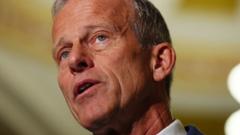Japan sets the stage for its Upper House elections, marking the first national vote since Prime Minister Shigeru Ishiba took office last year. With half of the seats up for grabs on Sunday, there’s notable tension within the long-dominant Liberal Democratic Party (LDP) as emerging right-wing populist factions begin to influence younger voters, threatening their established majority.
Japan's Upcoming Elections: Ishiba's Leadership in the Balance

Japan's Upcoming Elections: Ishiba's Leadership in the Balance
As Japan braces for critical Upper House elections, Prime Minister Shigeru Ishiba confronts potential political upheaval, testing the strength of the ruling Liberal Democratic Party amidst rising populism.
The electorate is particularly gripped by four pressing issues: challenging trade relations with the U.S., an increasingly assertive China, a fast-aging demographic, and the highest inflation rates seen in three decades. Notably, a surge in rice prices—a staple in Japanese diets—has drawn alarm among voters, exacerbated by poor harvests and governmental measures.
Additionally, discontent has grown regarding U.S. relations, with a sense of betrayal lingering from the Trump administration’s tariff threats that could harm Japanese exports unless the country grants further access to the troubled rice market and increases American vehicle imports.
Immigration remains a contentious topic, fueled by Japan's inclusion of an additional million migrant workers over the past three years to combat workforce shortages from a declining native population. This has provided fertile ground for populist parties like the Sanseito to capitalize on anti-immigration sentiments.
As Japan gears up for the polls, voters will likely consider electoral stakes beyond party lines. With the results due early Monday, both the ruling party and its critics await the outcomes that could reshape Japan’s political landscape moving forward.
What to Know:
1. **Election Overview**: Japan holds elections every three years, with voting scheduled from 7 a.m. to 8 p.m. on Sunday.
2. **Key Issues**: Inflation, trade, immigration, and populist movements are shaping the political discourse.
3. **Who’s involved**: Various political factions, including the LDP and emerging populists, navigate the ongoing election landscape.
Additionally, discontent has grown regarding U.S. relations, with a sense of betrayal lingering from the Trump administration’s tariff threats that could harm Japanese exports unless the country grants further access to the troubled rice market and increases American vehicle imports.
Immigration remains a contentious topic, fueled by Japan's inclusion of an additional million migrant workers over the past three years to combat workforce shortages from a declining native population. This has provided fertile ground for populist parties like the Sanseito to capitalize on anti-immigration sentiments.
As Japan gears up for the polls, voters will likely consider electoral stakes beyond party lines. With the results due early Monday, both the ruling party and its critics await the outcomes that could reshape Japan’s political landscape moving forward.
What to Know:
1. **Election Overview**: Japan holds elections every three years, with voting scheduled from 7 a.m. to 8 p.m. on Sunday.
2. **Key Issues**: Inflation, trade, immigration, and populist movements are shaping the political discourse.
3. **Who’s involved**: Various political factions, including the LDP and emerging populists, navigate the ongoing election landscape.





















